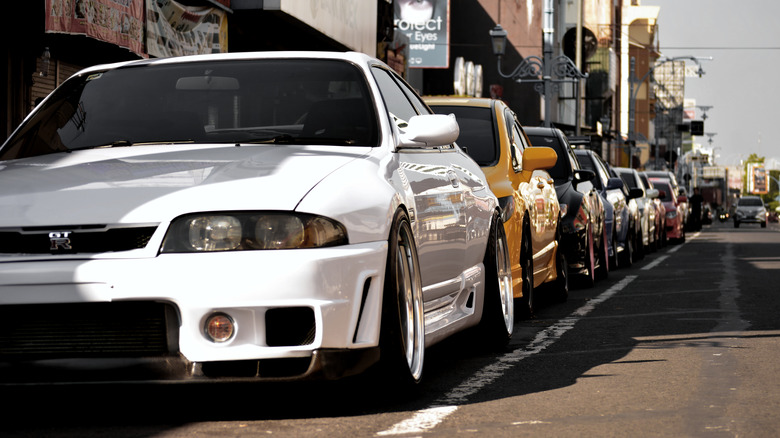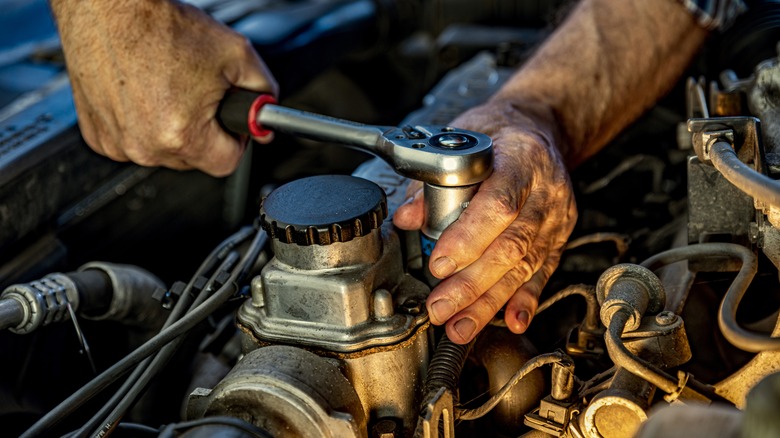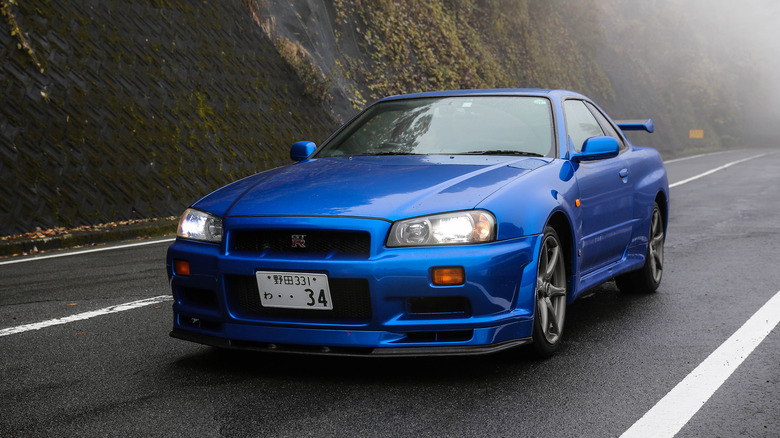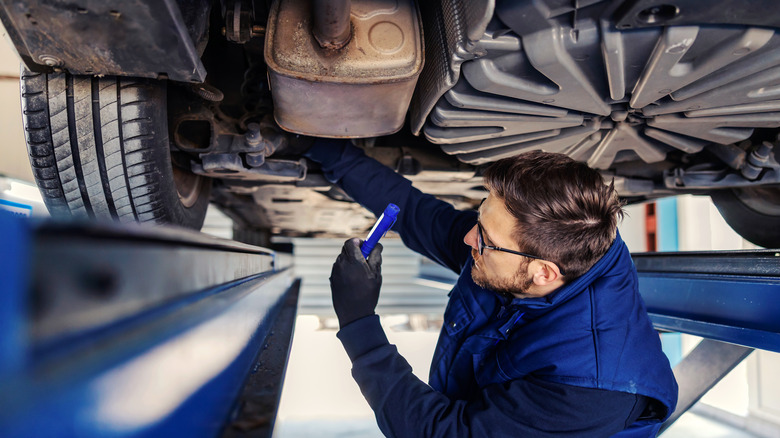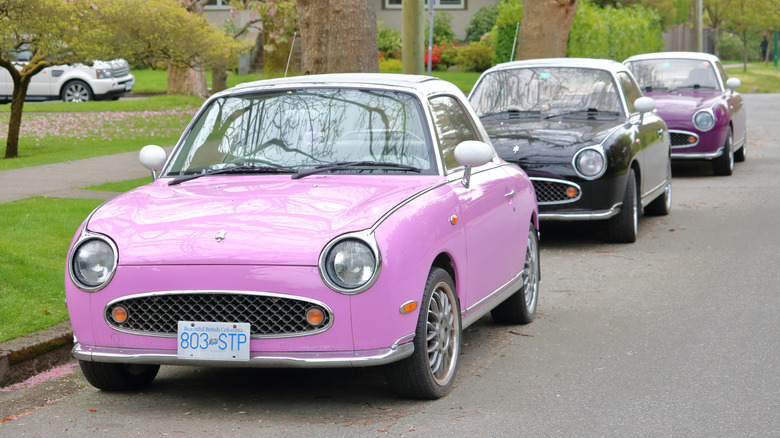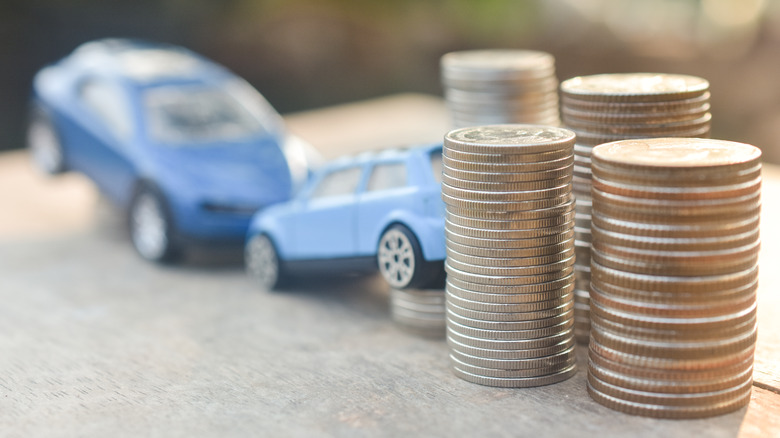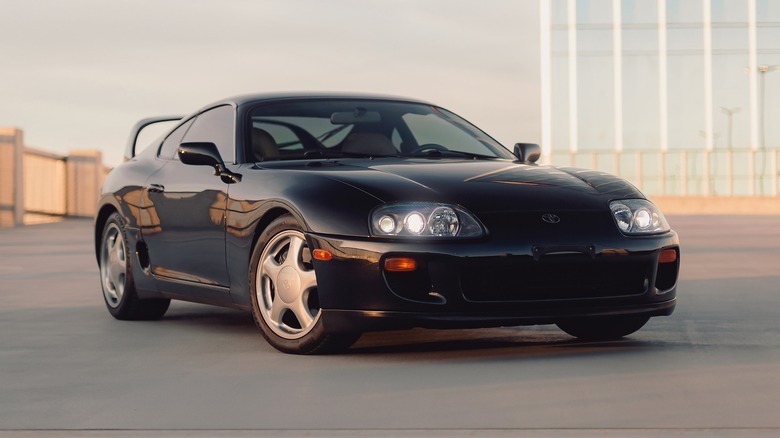The Biggest Problems With JDM Cars That Everyone Should Know
Japanese Domestic Market (JDM) cars are one of the most popular types of imports and give enthusiasts a way to get their hands on models or variants that were never sold in America. Often, the term "JDM" is most associated with performance cars from Japan's manufacturing golden era in the '80s and '90s, with Supras, Skylines, and RX-7s being among the most popular models. However, it can also refer to any kind of vehicle that was originally sold in Japan, and the car in question doesn't necessarily have to have been made by a Japanese manufacturer.
There are plenty of benefits to importing a JDM car — Japanese variants of globally-sold cars often boasted higher or exclusive specs, plus the Japanese have a reputation for taking care of their cars better than American owners. If you're importing a car that was never sold at all in America, then you'll own something that very few others in the U.S. have, and it'll be a guaranteed conversation starter at shows and meets. However, alongside the advantages, there are plenty of pitfalls that buyers can fall into when buying a JDM, so it's worth making sure you know the most common problems before you buy.
Right-hand drive can be tricky
Japanese drivers, much like the Brits and Australians, drive on the left hand side of the road, and as a result, their cars are right-hand drive. There are no legal issues with driving an RHD car in the United States, but it's still useful to be aware of the effect it can have on your driving, especially if you've never driven one before. Sitting on the opposite side to usual means your visibility will be greatly reduced, so things like overtaking need to be dealt with carefully.
Assuming you're buying a manual, the gear shifter will also be on the "wrong" side, and the wipers and turn signals can be the other way around. None of this is inherently an issue, of course, but it's more that it'll take some getting used to. Relearning the positioning of the controls will take some time, so it's worth being hyper-aware of your driving until you settle into your new car.
Lack of English-language manuals
Swapping from left-hand to right-hand drive might be pretty easy to figure out, but a manual that's only in Japanese might be a bit trickier to get to grips with. The amount of English-language documentation will vary by make and model, but as a general rule of thumb, the most popular imports will be easier to find English manuals for. Enthusiast sites are a great place to start, with plenty of helpful owners usually on hand to point you in the right direction if you're looking for one document or manual in particular.
This is assuming you're looking to take care of maintenance yourself, of course — if you'd prefer to let someone else do it, then you'll have to find an appropriately knowledgeable specialist. Depending on what car you're buying and where you are in the country, the nearest specialist might be several hours' drive away, making it both costly and inconvenient to get the car worked on. This problem will be compounded if you're buying an especially obscure JDM car with very few examples outside of Japan, where there will likely be no official English-language manual and very few shops (if any) with the knowledge to work on it.
Parts can be very costly
Finding parts can also be an issue for JDM cars, especially if you own a car that was never sold in large numbers, to begin with. The trick is to find out which parts on your car are shared with models that were sold in America — this should help keep costs down, and it'll be a lot easier than trying to source the equivalent part from Japan.
If your car doesn't share many parts, then enthusiast forums are the most effective way to find anyone who might have a stash of already-imported parts for your particular model. If you're still drawing a blank after that, then finding a parts supplier in Japan is your best bet. Shipping is an important consideration for the latter option, as it'll add a significant amount of time and money to your bill. For the rarest cars or most hard-to-find parts, you might not have much choice.
Japanese auctions are tricky to navigate
A lot of used cars in Japan are sold via auction, but if you're unfamiliar with the process, it's best to entrust a reputable importer to bid on your behalf. They will, in turn, liaise with an exporter in Japan, who can place bids and deal with the export paperwork when it's time to ship the car. Auction listings aren't always that informative, with Japan's grading system featuring very broad categories that don't necessarily reflect the specifics of what might be wrong with the car. An auction inspector's report will be available in Japanese, which should give a better idea of its condition.
There's also a chance that certain parts might go missing from your car between the time when you win the auction and when it arrives at your local port to be picked up. There are plenty of reports on owners' forums of aftermarket upgrades being ripped out sometime after the auction concludes, and you'll have very little comeback if this does happen. The easiest way to avoid all this is simply to buy from an import dealer with stock that's already Stateside, such as Duncan Imports. However, if you're looking for an obscure model or a car in a very particular condition, then navigating the auction process is almost inevitable.
History isn't always verifiable
The nature of buying a car at auction means that there's little in the way of guarantees when it comes to its history. This means buyers can be caught out by deceptive exporters looking to score premium prices for lower-quality cars, sometimes winding back odometers or altering documentation to show fewer previous owners. In most cases, there's no way to verify if a car's history has been altered or not, which is why it's so important to use a trusted exporter.
This practice is especially prevalent for the most in-demand JDM models, where an exporter can increase the value of their car by thousands of dollars by faking its documents. In one case highlighted by Get Cars Japan, an English car owner moved to Japan and brought their Japanese import Nissan Skyline GT-R with them. They eventually decided to sell it, and upon discovering further documentation from the car's original time in Japan, found the car had seven previous owners and had covered thousands more kilometers than its odometer suggested. The eventual value of the car was knocked down to nearly one-third of what the owner had paid for it in England, but if it hadn't been imported back to Japan, they'd likely never have known it had a fake history.
Hidden rust
The temperate climate in most parts of Japan means that the Japanese don't usually use salt on their roads, which is one of the biggest contributors to rust. As a result, most JDM cars don't feature the same kind of rustproofing that USDM cars do. This can be a problem if you're buying a JDM car that's already in the U.S. and the previous owner didn't adequately rustproof it, but it's also something to watch out for if you're buying directly from Japan. While, yes, most parts of Japan don't ever use salt on the roads, the coldest areas do. Not to mention, keeping a car by a coastal area with a sea breeze can cause serious rust issues even if the climate is generally warmer, and a lot of Japan's larger towns and cities are coastal.
As a result, it's best to be as thorough as possible when inspecting a potential purchase for any rust, trusting your exporter to carry out the task if the car is still in Japan. As soon as the car is in your possession, professionally rustproofing it will save a lot of hassle later down the line. If the car has already been in the U.S. for a while, be sure to check that the car was adequately protected as soon as it arrived and that any problem areas have been promptly dealt with.
Compliance and conversion problems
One of the biggest sticking points importers can face when trying to import unusual or rare vehicles to the U.S. is demonstrating to the NHTSA that the car can comply with American safety and emissions standards. The easiest way to do this is to have a certified registered importer (RI) confirm to the NHTSA that the car is substantially similar to one that's already on sale in America, and therefore it meets the standards, or that it's similar enough that the importer can modify it to conform.
This is generally easier with the most popular JDM models, but if you're importing something really obscure, it's unlikely that a "similarity" argument can be made. In that case, the importer would have to make the case to the NHTSA that the car in question would conform to U.S. regulations, providing adequate evidence before approval will be given. This can be both time-consuming and very costly, and there's no guarantee that the car will be certified at all. Buying through a reputable import company should mean that they take care of all this on your behalf, and they should be able to advise you on the likelihood of the car being certified before you purchase.
Importing to California is especially difficult
While registering a JDM car in some states is slightly more difficult than in others, there's one state that stands out from the other 49 as being particularly tricky: California. It's the strictest state in terms of emissions regulations, and it doesn't always consider imports in the same manner that the other states do. In fact, some JDM cars are considered "direct imports," meaning they require lab tests for emissions compliance before certification can be granted.
There is only one lab certified to conduct these compliance tests, and going through the process isn't cheap. Once the car gets lab-certified, it then needs to undergo further smog testing to gain a BAR label, and it can then be registered. Getting a car through this long-winded process requires a suitably knowledgeable importer, and it's not unheard of for buyers to get caught out by importers who claim to know what they're doing but then don't follow the proper procedure.
Insurance can be costly
How difficult it is to insure your freshly-imported JDM car will depend on make, model, and whether insurers have previously covered another car of the same type. For most of the popular JDM imports, it's not too difficult to find reasonably-priced insurance if you do some research, but more unusual cars might be harder to get quotes for. This is especially an issue for anyone importing a vehicle of relatively low value — most buyers of cheaper cars aren't going to want to spend a significant portion of the car's overall worth on their yearly premium.
This is also where having a reputable importer is useful, as they'll likely be able to advise you on the insurance companies that their previous clients have been accepted by. If you're working on a more modest budget, then it's always a good idea to try and get an idea of what the insurance premiums will be like for your imported car before you buy it. Like many of the other problems here, owner forums or your importer are both great places to start.
Resale values aren't always good
Despite all the headlines about low-mileage Supras and Skylines selling for massive sums, the reality is that most JDM cars aren't going to make you money if you decide to resell in a few years. For starters, bringing a car over from Japan requires all sorts of additional costs like shipping, import and registration fees, and conversion costs, none of which will be reflected in the car's resale value once it's in the U.S.
Even if the car's average resale value goes up over the time you own it, there's still no guarantee you'll be able to sell it for a profit — many of the highest JDM prices are achieved at auction, and it's always a gamble whether there will be two sufficiently interested bidders on the day to drive the price up. Obscure cars are even trickier to make money on, and some JDMs are almost guaranteed to waste your money if you buy them at current prices. It's best to try and ignore resale value altogether in most cases. Import a JDM car simply because you want to, not because you think its rarity or reputation makes it a smart investment.
